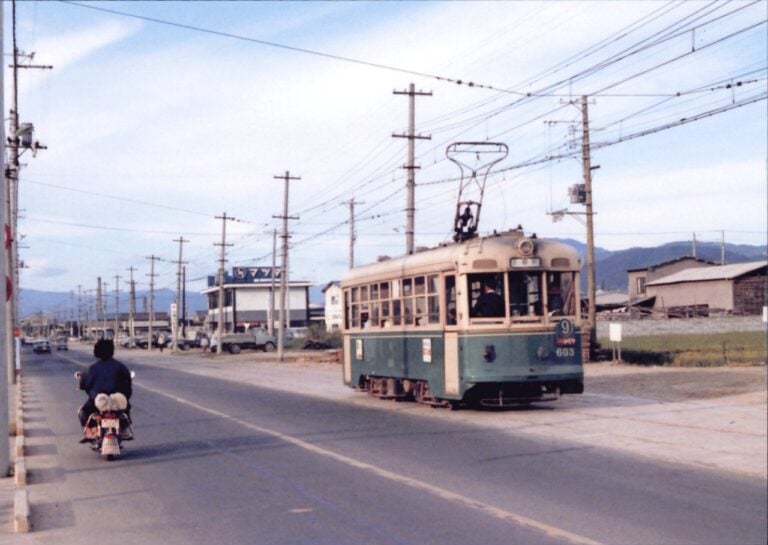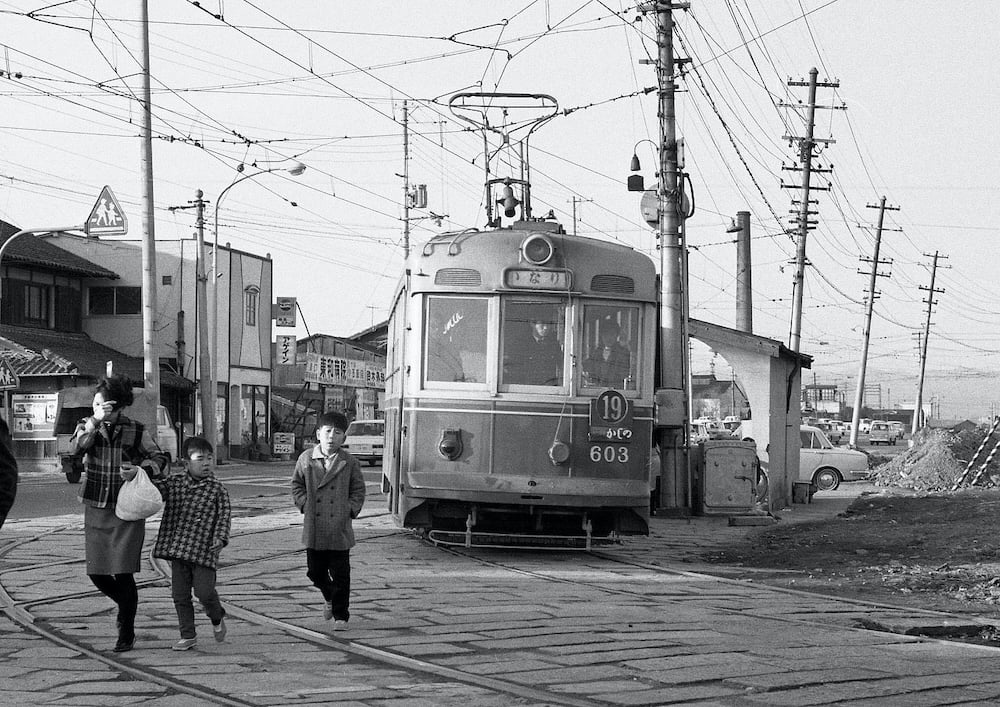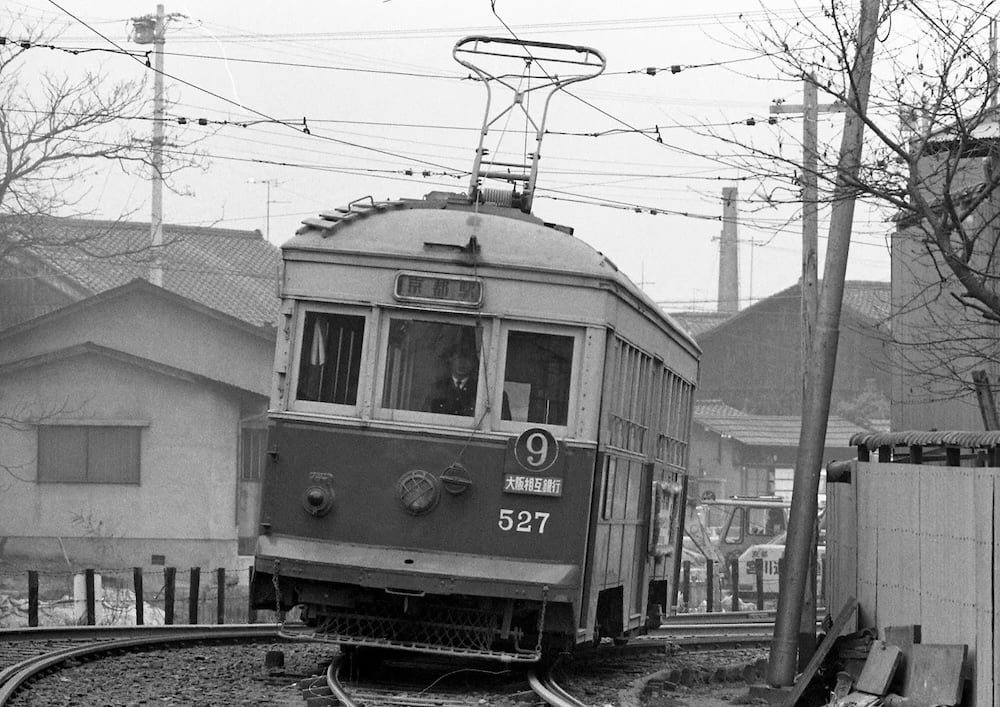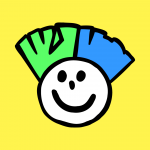
Everyone remembers their first experience in Japan—whether it’s the sensory whirlwind of Tokyo, the serene beauty of the countryside, or the countless small surprises in between that leave you in awe. For me, one of those magical surprises was discovering Japanese trams for the first time. My journey began in Nagasaki, home to two charming tram lines, where this nostalgic, rattling mode of transportation stole my heart. I even considered commemorating it with a tattoo! Join me as we dive into the rich history of Japan’s quirky trams and explore their unique role in today’s society.
The History
Japan’s first tramway opened in 1895 in Kyoto and operated until 1970. The Fushimi Line (伏見線, Fushimi-sen) emerged during Japan’s Meiji industrial revolution, a time when modernization swept the nation and public tramways became symbols of progress. Like its Western counterparts, Japan embraced this era of technological advancement, with the tramway system marking a pivotal step forward. The photos below evoke a sense of nostalgia for this bygone era, capturing a glimpse of the route that once turned left to one of its last stops, Chushojima (中書島, Chushojima). Today, a commemorative stone stands in Fushimi, inscribed with “The Birthplace of the Electric Railway Business” (電気鉄道事業発祥の地, Denkitetsudoujigyou Hasshonochi), making it a must-see off-the-beaten-track destination on my Kyoto list.

Fushimi Line Train

Leaning Tram
Trams gained popularity in Japan during the early to mid-20th century as the nation modernized and the era of convenient public transport began. Cities across Japan—including Tokyo, Osaka, Kyoto, Nagoya, Hiroshima, Nagasaki, Kagoshima, Sapporo, Yokohama, Kobe, Okayama, Toyama, and Takamatsu—adopted tram systems. However, with the expansion of underground rail networks and the rise of automobile use, demand for tramways steadily declined, and today only a handful of these cities continue to operate them. Remnants of this once-thriving industry can still be found in Hiroshima, Nagasaki, Kagoshima, Sapporo, Toyama, Okayama, and Matsuyama, as well as on the Tokyo Toden-Arakawa (都電荒川線, Toden Arakawa-sen), Kyoto’s Keifuku Randen Line (嵐電, Randen), and Osaka’s Hankai Tramway (阪堺電気軌道, Hankai Densha Hankai-sen).
Top Locations
While ten Japanese cities technically still operate tram systems, Kyushu is home to two of the most enchanting tramways that remain in use today. This westernmost island feels like a time capsule from a bygone era, standing in stark contrast to the sprawling modern metropolis of Tokyo—a reminder of its origins, yet unlikely to reconnect with that fast-paced lifestyle. The two cities I’m referring to are Nagasaki and Kumamoto. These cities continue to run vintage trams on their lines, and in our TikTok-driven age, they are poised to become the next social media sensations.
Nagasaki
Having lived in Nagasaki for five years, I feel a fierce loyalty—justifiably so—to this often-overlooked gem of Japan. Life in Nagasaki is still shaped by the charming old-fashioned trams that traverse the main streets. I loved that the city lacks an underground network, preserving these iconic vehicles for all to enjoy. Nothing brings me a sense of home quite like watching one of these majestic trams glide by. Nagasaki boasts four tram lines, but the two main ones—the red and blue trams—transport passengers along the primary route to all the must-see attractions for a very reasonable flat fare of 140 yen. Let me assure you, these trams remain bustling with activity. If you try to hop on during rush hour, prepare for a sardine-packed experience like no other! While it might be a bit frustrating for those accustomed to big-city comforts, this vibrant atmosphere is part of the city’s charm. I absolutely adore the trams of Nagasaki!

Nagasaki Tram
Step aboard one of these green cyclopean trams, and you’ll be transported to a simpler time. As the driver announces, “We’re departing now” (出発いたします, Shuppatsu itashimasu), he rotates the metal dial with distinct clunks, and the tram lurches forward, swaying gently as it goes. You’ll journey through all the most iconic parts of town, and when you’re ready to disembark, there’s nothing quite like the satisfying push of the mechanical STOP button to alert the driver. I truly cherish these tram systems.
But wait, there’s more! In 2017, the breathtaking Minato tram began its operations, adding a touch of beauty to Nagasaki’s streets. Its exterior is adorned in a shimmering metallic blue, symbolizing the city’s ocean, with charming depictions of short-tailed cats—local residents of Nagasaki. Inside, the tram features elegant wooden accents, stained glass windows that reflect the city’s Christian heritage, and exquisite Kumiko woodwork. And the best part? Riding this stunning piece of art costs the same fare as the regular trams! They run very regularly on the main 2 lines, so your chances are actually very high of being able to ride them. I implore you to make your way to Nagasaki, and you just might get lucky enough to ride one of these exquisite trams.

Minato Tram
Nagasaki’s passion for trams goes even further with its seasonal beer tram services, and it’s exactly what it sounds like! A couple of trams are transformed into vibrant spaces with tables and a small bar, offering unlimited beer as you ride along the iconic route for about two hours. Priced at around 5000 yen, these experiences require advance booking due to their popularity, but they are absolutely worth it if you manage to secure a ticket. Cheers to a delightful way to explore Nagasaki!
Kumamoto
Kumamoto trams are a charming and nostalgic mode of transport that offers a unique glimpse into the city’s history. The trams are easily recognizable by their striking black and yellow exteriors, reminiscent of the classic streetcars of yesteryear. Inside, passengers are greeted with wooden benches and vintage decor that evoke a sense of warmth and nostalgia. One of the tram system’s standout features is its incorporation of local culture; many trams are adorned with art and themes inspired by Kumamoto’s famous mascot, Kumamon (くまモン), adding a playful touch to the ride. With a flat fare of just 180 yen, hopping on a tram is an affordable way to explore the city, making it a favourite among both locals and tourists.













